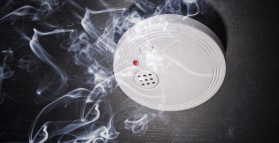Smoke Alarms

Are you up to date with Queensland’s Smoke Alarm Legislation? Have you taken precautions to protect yourself, your family and your home? From 1st January 2017, new laws regarding the installation of photoelectric smoke alarms in all Queensland homes came into effect. So what does the new smoke alarm legislation mean for you?
The new legislation states that every residence/dwelling is required to be fitted with:
- Photoelectric smoke alarms
- An interconnected smoke alarm system
- Smoke alarms in all bedrooms
- Smoke alarms in hallways
- Smoke alarms need to be either a hardwired interconnected system installed by a licensed electrician, or a system of 10-year lithium battery alarms with wireless interconnectivity.
When will this come into effect for you?
The installation timeframe is set within a 10-year rollout and will vary depending on your situation.
- If you are building a new home or significantly renovating the legislation is already in effect for you and has been since 1st January 2017.
- If you are leasing a home (a landlord) or selling a home the legislation will come into effect from 1st January 2022.
- All owner occupied dwellings will need to meet compliance by 1st January 2027.
- All smoke alarms being replaced after 1st January 2017 must be photoelectric alarms.
Why do I have to buy photoelectric smoke alarms?
Did you know that 78% of house fire deaths are between midnight and 8.00am? When you sleep, your sense of smell sleeps too.
Ionization alarms are known as a 'smelling' alarm as the smoke needs to fill the chamber and be sensed by the ion cycle to trigger the alarm in the same manner as needing an odour to fill your nostrils for your body to register a smell. The Ionisation smoke alarms are quite advantageous in detecting fast flaming fires, but most fire accidents at houses don’t happen this way. They also contain a small amount of radioactive substance and are prone to false alarms.
Photoelectric smoke alarms use a new technology that can detect a fire at its early stages. They are suggested to be the 'seeing' alarms as they sense fires through light and interference of lights pathways, similar to how we notice items when they are put within our line of sight. They respond faster to fires, sounding off during the smouldering stage. The most common type of fire in a home environment is a smouldering fire – that is a fire that burns slowly with smoke, but no flame. An added bonus of photoelectric smoke alarms is that they are less likely to trigger false alarms from cooking or bathroom steam. They are more sensitive detectors, meaning they are able to sense fires at the smouldering stage before it escalates.
A report based on research by Fire and Rescue and the CSIRO, into the effectiveness of photoelectric smoke alarms, showed stronger measures were needed to give residents time to escape. The research found that the death toll could be reduced by up to 50% if working smoke alarms were installed. The interconnection of multiple alarms ensures that if one alarm detects smoke, all other alarms will activate to sound a warning, which has proven most effective in saving lives.
How do I keep my smoke alarms working?
A hardwired smoke alarm is connected to a home’s 240v mains power supply and has a battery back-up.
If cooking smoke sets off the alarm, do not disable it. Turn on the your range hood, open a window or wave a towel near the alarm until the alarm stops beeping; or use the hush button (if fitted). Consider relocating the smoke alarm.
Once a month check by pressing the test button on your smoke alarm. If you cannot reach the button easily, use a broom handle.
Dust and debris can interfere with alarm functioning, so vacuum over and around your smoke alarm regularly.
Replace the backup battery on 240v alarms:
- rechargeable batteries - refer to manufacturer instructions
- non-rechargeable - replace annually.
Most alarms emit a short ‘BEEP’ sound when the batteries are low. This is your reminder to replace the battery.
Smoke alarms must never be painted.
Read the manufacturer instructions.
Hard-wired photoelectric alarms must be installed by an electrician.
You may have as little as 15 seconds to escape. Most fatal fires are preventable. Take precautions to protect yourself, your family and your home by creating a fire escape plan and ensure your smoke alarms are up to date.
If you would like a health check on your smoke alarms call us on (07) 3870 8446.
For more information visit https://www.qfes.qld.gov.au/community-safety/smokealarms/Pages/default.aspx